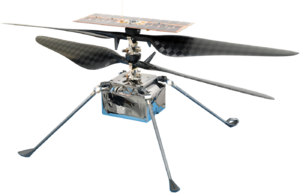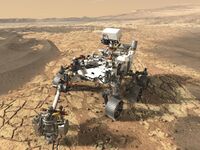Astronomy:Mars Helicopter Ingenuity
 Photographic profile of Ingenuity | |
| Spacecraft properties | |
|---|---|
| Spacecraft type | UAV helicopter |
| Manufacturer | Jet Propulsion Laboratory |
| Landing mass |
|
| Dimensions | |
| Power | 350 watts [3] |
| Start of mission | |
| Launch date | 30 July - 15 August 2020 |
| Deployed from | Perseverance |
| Entered service | 18 February 2021 (planned) |
| Instruments | |
 JPL's Mars Helicopter insignia | |
Ingenuity (also known as the Mars Helicopter)[4][5] is a robotic helicopter that is planned to be used to test the technology to scout interesting targets on Mars, and help plan the best driving route for future Mars rovers.[6][7] The small drone helicopter is planned for deployment in 2021 from the Perseverance rover as part of the Mars 2020 mission.[8] It is expected to fly up to five times during its 30-day test campaign, early in the rover's mission, as it is primarily a technology demonstration.[9] Each flight is planned to take no more than three minutes, at altitudes ranging from 3 to 10 m above the ground.[10] It could potentially cover a distance of up to 300 metres (980 ft) per flight.[10] It can use autonomous control and communicate with the Perseverance rover directly after each landing. If it works as expected, NASA could build on the design for future Mars aerial missions.[10] MiMi Aung is the project lead.[11] Other contributors include AeroVironment Inc., NASA Ames Research Center, and NASA Langley Research Center.[12]
Design
| Revolutions/min | Up to 2400 rpm[1] |
| Blade tip speed | < 0.7 Mach[5] |
| Flight time | Up to 90 seconds, once per day[3] |
| Operational time | 1 or more flights within 30 days[3] |
| Maximum range | Flight: 300 m (980 ft)[3][10] Radio: 1,000 m (3,300 ft)[10] |
| Maximum altitude | 5 m (16 ft)[3] |
| Maximum speed |
Ingenuity is designed to be a technology demonstrator by JPL to assess whether this technology can fly safely, and provide better mapping and guidance that would give future mission controllers more information to help with travel routes planning and hazard avoidance, as well as identifying points of interest for the rover.[13][14][15] The helicopter is designed to provide overhead images with approximately ten times the resolution of orbital images, and would display features that may be occluded from the rover cameras. It is expected that such scouting may enable future rovers to safely drive up to three times as far per sol.[16] This technology demonstration could form the foundation on which more capable aircraft can be developed for aerial exploration of Mars and other planetary targets with an atmosphere.[13][10][17] The next generation of rotorcraft may be in the range between 5 and 15 kg with science payloads between 0.5 and 1.5 kg. These potential aircraft could have direct communication to an orbiter and may or may not continue to work with a landed asset.[18] Future helicopters could be used to explore special regions with exposed water ice or brines where Earth microbial life could potentially survive. Mars helicopters may also be considered for fast retrieval of small sample caches back to a Mars ascent vehicle for return to Earth.[10]
The helicopter uses counter-rotating coaxial rotors about 1.1 m (3 ft 7 in) in diameter. Its payload is planned to be a high resolution downward-looking camera for navigation, landing, and science surveying of the terrain, and a communication system to relay data to the 2020 Mars rover.[19] Although it is an aircraft, it is being constructed to spacecraft specifications in order to endure the g-force and vibration during launch. It also includes radiation-resistant systems capable of operating in the frigid environment of Mars. The inconsistent Mars magnetic field precludes the use of a compass for navigation, so it is planned to use a solar tracker camera integrated to JPL's visual inertial navigation system. Some additional inputs include gyros, visual odometry, tilt sensors, altimeter, and hazard detectors.[20] It is designed to use solar panels to recharge its batteries, which are six Sony Li-ion cells with a nameplate capacity of 2 Ah.[10] The prototype uses the Qualcomm Snapdragon processor from Intrinsyc with a Linux operating system,[10] which also implements visual navigation via a velocity estimate derived from features tracked with a camera.[10] The processor is connected to two flight-control Microcontroller Units (MCU) to perform the needed flight-control functions.[10] Communications with the rover are through a radio link using Zigbee, implemented via 900 MHz SiFlex 02 chipsets mounted in both the rover and helicopter.[10] The communication system is designed to relay data at 250 kbit/s over distances of up to 1,000 m (3,300 ft).[10] The helicopter is planned to travel to Mars attached to the underside of the Perseverance rover and to be deployed to the surface between 60 and 90 Martian days after the landing. Then, the rover is expected to drive approximately 100 m (330 ft) away for the test flights to begin.[21][18]
Development
NASA's JPL and AeroVironment published the conceptual design in 2014 for a scout helicopter to accompany a rover.[12][22][23] By mid 2016, US$15 million was being requested to keep development of the helicopter on track.[24] By December 2017, engineering models of the vehicle had been tested in a simulated Martian atmosphere[10][2] and models were undergoing testing in the Arctic, but its inclusion in the mission had not yet been approved nor funded.[25] The United States federal budget announced in March 2018, provided $23 million for the helicopter,[26][27] and it was announced on 11 May 2018 that the helicopter can be developed and tested in time to be included in the Mars 2020 mission.[28] The helicopter underwent extensive flight-dynamics and environment testing,[10][29] and was then mounted on the underside of the Perseverance rover in August 2019.[30] Its mass is just under 1.8 kg (4.0 lb)[29] and it is designed to make up to 5 flights.[31][28] The helicopter was named by Vaneeza Rupani, an 11th grader at Tuscaloosa County High School in Northport, Alabama, who submitted an essay into NASA's "Name the Rover" contest.[4][32]
See also
- ARES – 2008 robotic Mars aircraft proposal
- Dragonfly – Robotic rotorcraft mission to Titan, launching in 2026
- Astronomy:Sky-Sailor – 2004 proposal of a robotic Mars aircraft
References
- ↑ 1.0 1.1 1.2 "Mars Helicopter Fact Sheet". NASA. February 2020. https://mars.nasa.gov/files/mars2020/Mars2020_Helicopter_Fact_Sheet.pdf.
 This article incorporates text from this source, which is in the public domain.
This article incorporates text from this source, which is in the public domain.
- ↑ 2.0 2.1 2.2 2.3 Helicopter to accompany NASA's next Mars rover to Red Planet. Stephen Clarke, Spaceflight Now. May 14, 2018
- ↑ 3.0 3.1 3.2 3.3 3.4 "Mars Helicopter". NASA. https://mars.nasa.gov/technology/helicopter/.
 This article incorporates text from this source, which is in the public domain.
This article incorporates text from this source, which is in the public domain.
- ↑ 4.0 4.1 Hautaluoma, Grey; Johnson, Alana; Agle, D.C. (April 29, 2020). "Alabama High School Student Names NASA's Mars Helicopter". NASA. https://www.jpl.nasa.gov/news/news.php?feature=7650.
 This article incorporates text from this source, which is in the public domain.
This article incorporates text from this source, which is in the public domain.
- ↑ 5.0 5.1 Mars Helicopter Scout. video presentation at Caltech
 This article incorporates text from this source, which is in the public domain.
This article incorporates text from this source, which is in the public domain.
- ↑ Chang, Kenneth (23 June 2020). "Mars Is About to Have Its "Wright Brothers Moment" - As part of its next Mars mission, NASA is sending an experimental helicopter to fly through the red planet's thin atmosphere.". The New York Times. https://www.nytimes.com/2020/06/23/science/mars-helicopter-nasa.html.
- ↑ Leone, Dan (November 19, 2015). "Elachi Touts Helicopter Scout for Mars Sample-Caching Rover". SpaceNews. http://spacenews.com/elachi-touts-helicopter-scout-for-mars-sample-caching-rover/.
- ↑ Agle, DC; Hautaluoma, Gray; Johnson, Alana (23 June 2020). "How NASA's Mars Helicopter Will Reach the Red Planet's Surface". NASA. https://www.jpl.nasa.gov/news/nws.php?feature=7684.
 This article incorporates text from this source, which is in the public domain.
This article incorporates text from this source, which is in the public domain.
- ↑ Decision expected soon on adding helicopter to Mars 2020. Jeff Fout. Space News. May 4, 2018.
- ↑ 10.00 10.01 10.02 10.03 10.04 10.05 10.06 10.07 10.08 10.09 10.10 10.11 10.12 10.13 10.14 Mars Helicopter Technology Demonstrator. (PDF) J. (Bob) Balaram, Timothy Canham, Courtney Duncan, Matt Golombek, Håvard Fjær Grip, Wayne Johnson, Justin Maki, Amelia Quon, Ryan Stern, and David Zhu. American Institute of Aeronautics and Astronautics (AIAA), SciTech Forum Conference; January 8–12, 2018, Kissimmee, Florida. doi:10.2514/6.2018-0023
 This article incorporates text from this source, which is in the public domain.
This article incorporates text from this source, which is in the public domain.
- ↑ MiMi Aung - Autonomous Systems Deputy Division Manager. NASA/JPL
 This article incorporates text from this source, which is in the public domain.
This article incorporates text from this source, which is in the public domain.
- ↑ 12.0 12.1 12.2 12.3 Generation of Mars Helicopter Rotor Model for Comprehensive Analyses. (PDF) Witold J. F. Koning, Wayne Johnson, Brian G. Allan. NASA Rotorcraft. 2018
 This article incorporates text from this source, which is in the public domain.
This article incorporates text from this source, which is in the public domain.
- ↑ 13.0 13.1 Brown, Dwayne; Wendel, JoAnna; Agle, D.C.; Northon, Karen (May 11, 2018). "Mars Helicopter to Fly on NASA's Next Red Planet Rover Mission". NASA. https://www.nasa.gov/press-release/mars-helicopter-to-fly-on-nasa-s-next-red-planet-rover-mission.
 This article incorporates text from this source, which is in the public domain.
This article incorporates text from this source, which is in the public domain.
- ↑ Chang, Kenneth. "A Helicopter on Mars? NASA Wants to Try". The New York Times. https://www.nytimes.com/2018/05/11/science/mars-helicopter-nasa.html.
- ↑ Gush, Loren (May 11, 2018). "NASA is sending a helicopter to Mars to get a bird's-eye view of the planet - The Mars Helicopter is happening". The Verge. https://www.theverge.com/2018/5/11/17346414/nasa-mars-2020-helicopter-atmosphere.
- ↑ Review on space robotics: Toward top-level science through space exploration (PDF). Y Gao, S Chien - Science Robotics, 2017.
- ↑ "Mars Helicopter a new challenge for flight". NASA. July 2018. https://www.jpl.nasa.gov/universe/archive/universe1807.pdf.
 This article incorporates text from this source, which is in the public domain.
This article incorporates text from this source, which is in the public domain.
- ↑ 18.0 18.1 "Mars Helicopter a new challenge for flight". NASA. July 2018. https://www.jpl.nasa.gov/universe/archive/universe1807.pdf.
 This article incorporates text from this source, which is in the public domain.
This article incorporates text from this source, which is in the public domain.
- ↑ Volpe, Richard. "2014 Robotics Activities at JPL" (PDF). Jet Propulsion Laboratory. NASA. https://www-robotics.jpl.nasa.gov/publications/Richard_Volpe/isairas%202014%20paper,%20volpe,%20v8.pdf.
 This article incorporates text from this source, which is in the public domain.
This article incorporates text from this source, which is in the public domain.
- ↑ Heading Estimation via Sun Sensing for Autonomous Navigation. Parth Shah. 2017.
- ↑ "NASA's Mars Helicopter: Small, Autonomous Rotorcraft To Fly On Red Planet". Shubham Sharma, International Business Times. May 14, 2018.
- ↑ J. Balaram and P. T. Tokumaru, "Rotorcrafts for Mars Exploration", in 11th International Planetary Probe Workshop, 2014.
- ↑ Benjamin T. Pipenberg, Matthew Keennon, Jeremy Tyler, Bart Hibbs, Sara Langberg, J. (Bob) Balaram, Håvard F. Grip and Jack Pempejian. "Design and Fabrication of the Mars Helicopter Rotor, Airframe, and Landing Gear Systems", American Institute of Aeronautics and Astronautics (AIAA), SciTech Forum Conference; January 7–11, 2019, San Diego, CA
- ↑ Berger, Eric (May 24, 2016). "Four wild technologies lawmakers want NASA to pursue". ARS Technica. https://arstechnica.com/science/2016/05/four-wild-technologies-lawmakers-want-nasa-to-pursue/.
- ↑ Dubois, Chantelle (November 29, 2017). "Drones on Mars? NASA Projects May Soon Use Drones for Space Exploration". All About Circuits. https://www.allaboutcircuits.com/news/nasa-projects-may-soon-use-drones-for-space-exploration-mars/.
- ↑ NASA Mars exploration efforts turn to operating existing missions and planning sample return. Jeff Foust, Space News. February 23, 2018
- ↑ NASA to decide soon whether flying drone will launch with Mars 2020 rover. Stephen Clarke, Spaceflight Now. March 15, 2018
- ↑ 28.0 28.1 Mars Helicopter to Fly on NASA's Next Red Planet Rover Mission. Karen Northon, NASA News. May 11, 2018
 This article incorporates text from this source, which is in the public domain.
This article incorporates text from this source, which is in the public domain.
- ↑ 29.0 29.1 Agle, AG; Johnson, Alana (March 28, 2019). "NASA's Mars Helicopter Completes Flight Tests". NASA. https://www.jpl.nasa.gov/news/news.php?feature=7361.
 This article incorporates text from this source, which is in the public domain.
This article incorporates text from this source, which is in the public domain.
- ↑ NASA's Mars Helicopter Attached to Mars 2020 Rover. NASA News – JPL. August 28, 2019
 This article incorporates text from this source, which is in the public domain.
This article incorporates text from this source, which is in the public domain.
- ↑ Yes, NASA Is Actually Sending a Helicopter to Mars: Here's What It Will Do. Sarah Lewin, Space. May 12, 2018.
- ↑ Agle, D.C.; Cook, Jia-Rui; Johnson, Alana (April 29, 2020). "Q&A with the Student Who Named Ingenuity, NASA's Mars Helicopter". NASA. https://www.jpl.nasa.gov/news/news.php?feature=7651.
 This article incorporates text from this source, which is in the public domain.
This article incorporates text from this source, which is in the public domain.
External links
- NASA Mars Helicopter webpage
- Mars Helicopter Technology Demonstrator. (PDF) — The key design features of the prototype drone.









